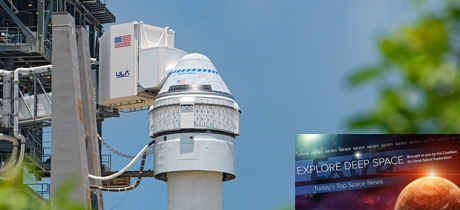In Today’s Deep Space Extra… Starliner’s Orbital Flight Test-2 delayed. The International Space Station considered one of the most significant works of postwar architecture.
Human Space Exploration
Launch of Boeing crew capsule scrubbed due to propulsion system issue
Coalition Members in the News – Boeing, United Launch Alliance
Spaceflightnow.com (8/3): Plans for a launch Tuesday of Boeing’s Orbital Flight Test-2 (OFT-2) mission was scrubbed due to unexpected pre-launch valve position indicators in the CST-100 Starliner’s propulsion system. A new date for the launch has not been set following what was the second postponement. Boeing said that a number of potential causes for the problem had been ruled out, including software.
SpaceLink to improve International Space Station comms with relay satellites
SpaceNews.com (8/3): The Center for the Advancement of Science in Space (CASIS), which manages the U.S. National Laboratory on the International Space Station (ISS), will provide funding for startup SpaceLink to equip the orbiting science lab to test a 10 gigabit/second optical communications terminal. The company plans to launch its first satellites in 2024. The space station demo is intended to validate a hybrid SpaceLink optical and radio frequency satellite and ground network with an optical terminal technology available to the astronauts on board for research and communications with ground personnel.
Space Science
NASA science chief says it’s OK to be “worried” or “terrified” about James Webb Space Telescope
Ars Technica (8/3): Daring NASA science missions, with groundbreaking challenging objectives, can be accompanied by periods of commotion for those involved in the preparations and operations, explains Thomas Zurbuchen, NASA’s associate administrator for science. Zurbuchen says that for most missions, launch contributes most of the mission risk: if the spacecraft is in space, most risk is taken care of. There are missions, however, that are different, with most risk coming after launch. He cites the Perseverance rover and the James Webb Space Telescope (JWST). “We are where we are because JWST has some of the best engineers and leaders I have ever met, and they have continued when others were ready to give up,” says Zurbuchen of JWST, which has undergone lengthy development.
GOES-17 satellite bounces back from glitch while monitoring California wildfires
Space.com (8/3): NOAA’s GOES-17 weather satellite has recovered from a July 22 anomaly that was perhaps caused by a computer malfunction. The satellite launched in 2018 and the victim of previous disruptions, apparently went into safe mode in late July, prompting ground teams to address issues with the satellite’s Advanced Baseline Imager and magnetometer.
Other News
Military communications payloads could hitchhike on future GPS satellites
Coalition Member in the News – Lockheed Martin
SpaceNews.com (8/3): In a request for information, the U.S. Space Force announced it is considering adding new communications capabilities to its next generation of Global Positioning Satellites (GPS), which are being developed by Lockheed Martin and projected to begin launching in 2026. Those hosting new communications capabilities would follow in 2030. The GPS satellites would be equipped for X, Ka and perhaps other bandwidth communications, providing the Department of Defense (DoD) with an additional layer of connectivity in medium Earth orbit.
Chinese commercial rocket Hyperbola-1 fails in return to flight attempt
NASAspaceflight.com (8/3): China’s iSpace private launch services provider attempted unsuccessfully on Tuesday to carry out a return to flight for the Hyperbola-1 (SQX-1) rocket, which experienced a failure in February on its second mission.
Diversion
The 25 most significant works of postwar architecture
The New York Times (8/2): Three architects, three journalists, and two designers made a list of the most influential and lasting buildings that have been constructed or cleverly updated since World War II. The group included the International Space Station (ISS): “There is something symbolic about the ISS in terms of getting people to [work together] from foreign nations, and there is also something really fascinating about it being made on Earth but architected in space. It’s more significant than almost any other building: It shows the imagination of the human race,” said designer Tom Dixon. (Editor’s note: this news source is behind a tiered paywall).

